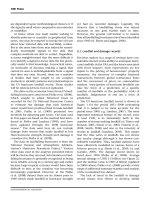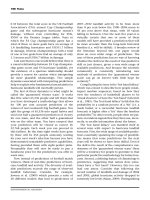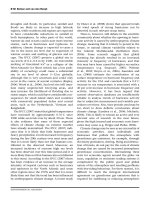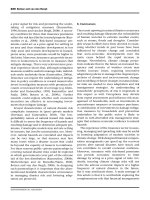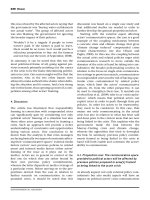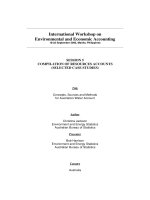Climate change as environmental and economic hazard - phần 2.2
Bạn đang xem bản rút gọn của tài liệu. Xem và tải ngay bản đầy đủ của tài liệu tại đây (99.98 KB, 8 trang )
droughts and floods. In particular, rainfall and
floods are likely to increase in high latitude
regions, while southern arid regions are expected
to have considerable reductions in rainfall in
both hemispheres. In other parts of the world,
warmer air and oceans could cause more intense
storms, such as hurricanes and typhoons. In
addition, climate change is expected to cause a
rise in the mean sea level due to expansion of
warmer oceans and melting of glaciers and ice
caps. The IPCC (2007) projects a global rise in
sea levels of 0.2–0.6 m by 2100. An irreversible
melting of Greenland ice
4
or a collapse of the
West-Antarctic Ice Sheet (which has a low prob-
ability of occurring) could cause a substantial
rise in sea level of about 5–12 m globally,
although this is very uncertain and could only
occur in the course of several centuries (Rapley,
2006; Wood et al., 2006). Sea level rise will inun-
date many unprotected low-lying areas, and
may increase the likelihood of flooding due to
storm surges, which could have considerable con-
sequences for small island states and countries
with extensively populated deltas and coastal
areas, such as the Netherlands, Vietnam and
Bangladesh.
The IPCC (2007) states that global temperatures
have increased by approximately 0.768C since
1900 while sea levels rose by about 20 cm. There
is also evidence that some of these expected
effects of climate change on extreme weather
have already materialized. The IPCC (2007) indi-
cates that it is likely that both heatwaves and
heavy precipitation events increased in frequency
during the late 20th century over most areas and
that it is more likely than not that humans con-
tributed to the observed trend. Moreover, an
increased incidence of extreme high sea levels
has been observed over this time period and it is
more likely than not that humans also contributed
to this trend. According to the IPCC (2007) there
has been evidence of an increase in the average
intensity of tropical cyclones such as hurricanes
and typhoons in the North Atlantic and some
other regions since the 1970s and that it is more
likely than not that the trend has been influenced
by anthropogenic climate change. A recent study
by Elsner et al. (2008) shows that upward trends
for wind speeds of strong hurricanes can be
observed in each relevant ocean basin.
There is, however, still debate in the scientific
community about whether the upswing in hurri-
cane activity is caused by anthropogenic climate
change, meaning that it is likely to persist in the
future, or natural climate variability related to
the Atlantic Multidecadal Oscillation (Kerr,
2006). Some research suggests that global
warming has already resulted in an increased
intensity or frequency of hurricanes, and that
this may have been caused by higher sea surface
temperatures (e.g. Emanuel, 2005; Webster
et al., 2005; Hoyos et al., 2006). Saunders and
Lea (2008) estimate the contribution of sea
surface temperature on hurricane frequency and
activity for the USA and conclude that a 0.58C
increase in sea temperature is associated with a
40 per cent increase in hurricane frequency and
activity. However, it has been argued that
current observation databases are insufficiently
reliable to analyse trends of hurricane activity
due to subjective measurement and variable pro-
cedures over time. Also, time periods used may be
too short to draw definite conclusions about
climate change (Landsea et al., 2006; Michaels,
2006). This is likely to remain an active and very
relevant area of research in the near future,
given the high insured and economic costs hurri-
canes may cause (e.g. Ho
¨
ppe and Pielke, 2006).
Climate change may be seen as an externality of
economic activities, since individuals and
businesses that pollute the atmosphere with
greenhouse gas emissions, for example, through
electricity generation, driving, flying and destruc-
tion of forests, do not pay for the costs of climate
change that are caused by increased atmospheric
greenhouse concentrations. Internalizing these
costs for economic agents around the globe via
taxes, regulation or emissions trading systems is
complicated by the public good and global
nature of the atmosphere and resulting problems
with free-riding behaviour. For these reasons, it is
difficult to reach the stringent international
agreement on greenhouse gas emissions that is
required for stabilizing or reducing atmospheric
212 Botzen and van den Bergh
ENVIRONMENTAL HAZARDS
concentrations of greenhouse gases. Future green-
house gas emissions may rise rapidly due to the fast
industrialization of Asian economies with increas-
ing demands for energy (Botzen et al., 2008).
Nevertheless, even in the unlikely case that emis-
sions could be reduced to zero, warming would
continue for several decades because of the lag in
response time of the climate system caused,
among others, by the past emissions that persist
in the atmosphere for a very long time. This high-
lights the necessity of examining the effects of
climate change on extreme weather events and
resultant damage and designing adequate adap-
tation policies to manage potential changes in
these risks (Pielke et al., 2007).
3. Assessing natural catastrophe risk
3.1. Expert modelling of natural disaster risk
Assessments of future risk are inherently difficult
because of the uncertainties associated with the
impacts of climate change and socio-economic
development on future natural disaster risk
(IPCC, 2007). Considerable uncertainty and
ambiguity is associated with both the frequency
of a disaster occurring and the damage that it
will cause. Constructing different scenarios of
climate and socio-economic change and estimat-
ing their influence on risk may be a useful first
step in assessing future risk. Statistical models
can be used to assess how frequencies and severi-
ties of natural disaster or disaster damage relate to
variability in climate (e.g. Saunders and Lea,
2008; Schmidt et al., 2009). Extrapolations of
such historical relations under changes in
climate conditions may then provide insights
into future risks (e.g. Botzen et al., 2009b). More-
over, catastrophe models are commonly used to
assess exposure to natural disaster risk (Grossi
and Kunreuther, 2005). Such computer-based
models estimate the loss potential of catastrophes
by overlaying the properties at risk and the poten-
tial sources of natural hazards in a specific geo-
graphical area with the use of Geographic
Information Systems (GIS).
Figure 2 shows a schematic overview of the main
components of catastrophe models (Grossi and
Kunreuther, 2005). The natural hazard module
of a model characterizes the physical character-
istics of the hazard, such as the location of a
flood, flood depth and flow velocities of water,
wind speeds, and frequency of occurrence of the
hazard. The portfolio of properties at risk com-
ponent of the model can include various charac-
teristics of assets, such as the location, age and
type of buildings or land use. The vulnerability
component of the model quantifies the impact
of the natural hazard on the properties at risk,
which may be done by the use of damage curves
that describe the relation of physical parameters,
e.g. flood depth, with damage to the inventory,
such as flood damage to buildings (e.g. Merz
et al., 2004). The resulting damage to the portfo-
lio of properties is computed based on these vul-
nerability measures and may consist of direct
losses, indirect losses or both. The output of
such models may be represented as exceedance
probability curves that indicate the probability
of a certain loss being surpassed or geographical
maps that show levels of risk (Bouwer et al.,
2009; de Moel et al., 2009). Examples of users of
catastrophe models are insurers who use them
to assess their financial exposure to natural
hazards and governments that are interested in
evaluating the geographical exposure to risks or
the effectiveness of protection measures, such as
dikes or building codes.
Over time, catastrophe models need to be
updated due to socio-economic developments
and climate change. In case climate change
increases the frequency or severity of extreme
weather, the ‘natural hazard’ component of the
model needs to be adjusted to reflect increased
risks. Socio-economic developments, such as
FIGURE 2 Main components of catastrophe models
Source: Adapted from Grossi and Kunreuther (2005)
Managing natural disaster risks 213
ENVIRONMENTAL HAZARDS
increased urbanization in hazard-prone areas,
may require changes in the ‘portfolio of proper-
ties at risk’ component over time.
As an illustration, Aerts et al. (2008a) have esti-
mated the independent influence of climate
change and socio-economic developments on
flood risk, defined as probability
*
damage,inthe
Netherlands until the year 2100. Two extremes
were studied in order to gain insights into the
effectofurbangrowthontheonehandand
climate change on the other.
5
Effects of climate
change were modelledusingthree sea levelrisescen-
arios of 60, 85 and 150 cm per 100 years, which
influence the flood probability (‘natural hazard’
component in Figure 2). Furthermore, changes in
urban development were assessed using two
scenarios, namely low economic growth (RC) and
high growth (GE) and corresponding changes in
the ‘portfolio of properties at risk’ module of
Figure 2 were based on a land use model of the Neth-
erlands (Janssen et al., 2006). The results shown in
Figure 3 indicate that a moderate rise in sea level of
60 cm results in a similar increase in potential
damage as a high economic growth scenario.
Climatechangeeffectsonlydominateforvery
high increases in sea level. These results indicate
the importance of directing adaptation policies to
limit both a possible rise in probabilities and
damage caused by natural disasters (see Section 4).
3.2. Households' assessments of risk and
behaviour
3.2.1. Individual risk perception
In evaluating hazards people commonly rely on
intuitive risk judgements, known as risk percep-
tions, which often differ considerably from
expert assessments (Slovic, 1987; 2000). The
understanding of risk perception of individuals
is very important in designing adaptation pol-
icies. Household risk judgements can determine
the perceived legitimacy as well as compliance
with land-use planning and other adaptation pol-
icies (Peacock et al., 2005). Moreover, individual
perceptions of hazards are important factors
behind decision making under risk with respect
to insurance purchases and the undertaking of
self-protective measures (Burn, 1999; Flynn
et al., 1999; Botzen et al., 2009c).
Individuals often use simple rules when they
assess risks, which may be described as heuristics
(Kahneman et al., 1982). Individuals may use
the ‘availability heuristic’ in judging natural
hazard risk, which implies that they judge an
event as risky if it is easy to imagine or recall.
For example, individuals who have experienced
a disaster may find it easier to imagine that the
disaster will happen again in the future and
therefore indicate a higher perceived risk than
individuals without this experience. Individuals
often rely on affective feelings when they judge
the level of risks, which may deviate from pure
logical and analytical reasoning (Loewenstein
et al., 2001; Slovic et al., 2004). Individuals
may have a higher risk perception if natural
hazards are associated with negative feelings,
which may have been caused or reinforced by
experiences with damage caused by natural
hazards or evacuation because of disaster (Finu-
cane et al., 2000; Keller et al., 2006). Often
natural disasters have very low frequencies of
occurrence so that individuals may have a very
low risk perception or even neglect the risk
altogether (Botzen et al., 2009d). Governments
can undertake information campaigns if individ-
ual risk perceptions deviate considerably from
expert risk judgements.
FIGURE 3 Assessment of future flood risk in the Nether-
lands under a range of climate change and socio-economic
scenarios
Source: Aerts et al. (2008a)
214 Botzen and van den Bergh
ENVIRONMENTAL HAZARDS
3.2.2. Individual behaviour under risk
Economists commonly use the expected utility
framework in analysing individual decision
making under risk, such as insurance purchases.
However, in many cases this framework fails to
adequately describe behaviour in practice,
especially in the case of low-probability, high-
impact risks such as natural disasters (e.g.
Mason et al., 2005). A reason for this is that indi-
viduals often deviate from rational behavioural
principles when they make decisions under risk
(Kahneman, 2003). In particular, a common
observation is that individuals either overesti-
mate or neglect low-probability risk (Tversky
and Kahneman, 1992). This processing of risk
poses some difficulties when applying the tra-
ditional expected utility framework of individual
decision making under risk (von Neumann and
Morgenstern, 1947), which assumes that individ-
uals correctly assess the likelihoods of adverse
events and that individuals process probabilities
linearly. The descriptive failure of expected
utility theory in explaining individual behaviour
under risk is well documented (Camerer, 1998).
Alternative theories that allow for the modelling
of individual attitudes toward probabilities or
‘probability weighting’ may be more suitable to
model individual behaviour. Important examples
are prospect theory and rank-dependent utility
theory (Kahneman and Tversky, 1979; Quiggin,
1982; Schmeidler, 1989; Tversky and Kahneman,
1992). Allowing for ‘bounded rationality’ or
limitations in individuals’ perceptive and cogni-
tive capabilities is fundamental in correctly
anticipating individual responses to risky
events, such as demand for insurance coverage
against natural disasters (Botzen and van den
Bergh, 2009a).
4. Managing natural hazards risks
4.1. Economic resilience to natural disasters
A potentially important concept in managing
natural disaster risk is the notion of resilience,
even though its broad meaning has obstructed
its use in risk management (Klein et al., 2003).
As Boc
ˇ
karjova (2007) and Rose (2007) discuss,
resilience has been defined differently in various
disciplines, such as ecology (from where the
concept originates), engineering and economics,
as well as between various authors. Resilience
has two main interpretations, namely the time
necessary for a disturbed system to return to its
original state (Pimm, 1984) and the amount of
disturbance a system can absorb before moving
to another state (Holling, 1973; 1986). Rose
(2004b), who defines resilience from an econ-
omics perspective, relates resilience to the time
needed for recovery in the aftermath of a disaster
in the sense that a higher level of resilience allows
the economy to recover faster at lower costs.
Moreover, Rose (2004a; 2006) regards resilience
as a post-disaster characteristic that comprises
the inherent and adaptive responses to disasters
that result in the avoidance of potential losses.
In his definition, resilience encompasses the
ability of societies to limit or prevent losses
during and after a disaster, and emphasizes inge-
nuity and resourcefulness applied.
In the context of climate change Timmerman
(1981) defines resilience as the capacity to
absorb and recover from the occurrence of a
hazardous event. Resilience is related to adap-
tation, which comprises adjustments ex ante of
the occurrence of a disaster aimed at creating con-
ditions within the human system that enhance
this system’s resistance to disasters and its
capacity to respond to, and cushion impacts of,
a disaster (Handmer and Dovers, 1996; Boc
ˇ
kar-
jova, 2007). Boc
ˇ
karjova (2007) adds to the defi-
nition of resilience the ability of the
human-induced system to exhibit learning so as
to improve its protective mechanisms (adap-
tation) in the face of disasters. Resilience may be
spatially dependent and differ between regions
within the same country. For example, Porfiriev
(2009) argues that megacities may have a higher
resilience capacity than small towns, because
the latter often lack economic resources to ame-
liorate impacts of a disaster. Climate change
increases the need for resilience since it may
lead to more disturbances of the human system
Managing natural disaster risks 215
ENVIRONMENTAL HAZARDS
due to an increased frequency and severity of
weather extremes. Improving resilience (accord-
ing to the aforementioned definitions) and adap-
tive capacity may thus be seen as a desirable
policy instrument to manage natural disaster
risks (Tobin, 1999).
4.2. Risk management strategies
4.2.1. Hazard prevention to reduce the probability
of suffering damage and expected costs of
damage
Preventing the hazard from occurring and redu-
cing the probability or expected costs of suffering
damage is an effective strategy for limiting risk of
certain natural hazards, such as flooding, while it
may be more difficult for others, such as storms.
Examples of strategies that limit the probability
of suffering damage are the creation of dams for
flood control, dikes, storm surge barriers and relo-
cation of property out of hazard-prone areas.
Investments in hazard prevention are usually
undertaken by governments because of the
public good characteristics of protection of infra-
structure. There seems to be considerable scope to
improve cost-effective prevention or damage
mitigation strategies worldwide. It has been
suggested that worldwide investments of USD40
billion in disaster preparedness, prevention and
mitigation would have reduced global economic
losses by USD280 billion during the 1990s
(IFRC, 2001).
Public support for large investments in protec-
tion infrastructure often only arises after a disas-
ter has occurred. For example, strategies to
prevent flood damage are well developed in
countries around the North Sea and in Japan,
where flooding claimed many lives until the
middle of the 20th century. After a catastrophic
flood in 1953 the Dutch built their famous Delta-
works; a series of dams, sluices, dikes and storm
surge barriers constructed between 1958 and
1997 in the south-west of the Netherlands (Aerts
and Botzen, 2009). This flood protection infra-
structure was successful in ensuring high safety
standards that in some areas protect against
storm surges with a recurrence interval of 1 in
10,000 years. Cost–benefit analysis may guide
the determination of safety standards and protec-
tion investments, as has been done in the Nether-
lands (van Dantzig, 1956; Jonkman et al., 2004). A
drawback of hazard prevention with engineering
infrastructure is that it may be perceived by
households and companies that the risk is elimi-
nated instead of reduced, which can encourage
economic development in hazardous areas (Vis
et al., 2003).
Once in place, a continuous updating of pro-
tection infrastructure is needed, notably in areas
that are impacted by a rapid increase in the fre-
quency of hazards due to climate change or by
an increase in potential damage that may be
caused by socio-economic developments in the
protected areas. A proactive or anticipatory
approach that reduces vulnerability before
climate change results in adverse impacts, such
as floods, may be desirable (Klein et al., 2003).
The success of measures limiting risk will
depend on the magnitude and rate of change of
the climate; large changes that occur rapidly
may be difficult to accommodate. Large regional
variations exist in climate change impacts indi-
cating that a variety of strategies needs to be
implemented in different areas that may be
affected by higher flood, drought or storm risks
(IPCC, 2007).
Current prevention measures may be
inadequate to deal with climate change. For
example, at this moment, the storm surge barriers
of the Deltaworks in the Netherlands are insuffi-
ciently prepared for (further) rises in sea level
and are likely to require adjustments in the
future. A cost –benefit analysis performed by
Aerts and Botzen (2009) of the ‘Haringvliet’
barrier that is part of the Deltaworks indicates
that adapting the barrier to climate change
instead of replacing it completely is a good invest-
ment. Unfortunately, adjusting the construction
of some barriers to sea level rise is not possible.
In designing hazard prevention or damage miti-
gation measures it is, therefore, advisable to con-
sider flexible infrastructure that allows for
adjustments to climate change, especially given
216 Botzen and van den Bergh
ENVIRONMENTAL HAZARDS



